#1918 - March 19
Explore tagged Tumblr posts
Text
Dr. Yosef Ben-Jochannan, one of the world’s most pre-eminent and prolific scholars of African history, passed away early yesterday morning in New York City at the stunning age of 97.
It was only fitting that one of the most courageous and inspiring scholars of our time would live for nearly a century, paying personal witness to dramatic transformations in the lives of Black people across the globe. But more than anyone, Dr. Ben—as he was affectionally called by generations of his devoted followers—knew that a world transformed was not a world complete. Black people might have lifted themselves from widespread subjugation, but they still suffered and were far from the glorious civilizations in Africa about which Dr. Ben taught millions of eager charges.
One of his many specialties was the ancient civilization of Kemet in Egypt. He was one of the first true Egyptologists, before that title had even come into vogue. Dr. Ben was always a controversial figure because he had no interest in trying to placate white scholars or writers who were threatened by his claims about Africa, Europe and the Middle East.
Because generations of white orthodoxy had moved the Western world to accept as fact questionable scholarship about the preeminence of European rulers and thinkers, Dr. Ben was always willing to take down these Western myths, one by one.
Dr. Ben turned 97 on New Year’s Eve and had plans to celebrate many more. But his friends took note of his diminishing appetite—though close colleagues like Dr. Leonard Jeffries and Prof. James Small were forced to go onto the Internet earlier this month to debunk rumors that he had already passed. At 3:30 am on Thursday morning, he bid his farewell.
“He was one of last great race men of his era,” Nayaba Arinde, Amsterdam News Editor, said on the Amsterdam News website. “He was a master teacher who just wanted to share our amazing African history. He was a man of the people. He was always amongst us, educating, and sharing. Sitting with him was a gift of tremendous proportions. He was loved, and he loved his people.”
He was like a library of African history onto himself, as if a wing of one of the world’s great research institutions had been poured into one brain and become ambulatory.
For those in the New York tri-state area in the 1970s and 1980s, he was a familiar presence and voice from his frequent appearances on Gil Noble’s weekly Black-focused television show “Like It Is” and on the Afrocentric radio station WLIB. It was an important time for him to spread his teachings about the glory of ancient African civilizations—coming out of the tumult of the Civil Rights Movement and the uplifting of the Black Power Movement, young Black people were eager to soak up his words, to extend their communion with their past far beyond the enraging lessons of slavery.
He often worked together with another legendary scholar, Dr. John Henrik Clarke, who died in 1998.
During his immense life, Dr. Ben journeyed from his birth in Ethiopia, to a Puerto Rican mother and an Ethiopian father, studying in institutions ranging from Puerto Rico to Cuba to Brazil to Spain. After earning a B.S. in Civil Engineering at the University of Puerto Rico, he went on to earn a Master’s degree in Architectural Engineering from the University of Havana, Cuba and then doctoral degrees in Cultural Anthropology and Moorish History from the University of Havana and the University of Barcelona, Spain.
He taught many years at such institutions as City College in New York City and Cornell University.
His authorship extended to 49 books, many focusing on Egypt and the civilizations of the Nile Valley.
In 2002, Dr. Ben—who lived in Harlem his later years—donated to the Nation of Islam his personal library of more than 35,000 volumes, manuscripts and ancient scrolls.
“Of all our greats, Dr. Ben physically took tens of thousands of scholars, activists, students and associations to the Nile Valley to make the pages of his book more authentic,” said his colleague, Reggie Mabry. “We saw our own experiences of what he wrote… For that the Black world is indebted to this Black man of the Nile and his family.”
#ABS Celebrates the Life of a Great Man and Legendary Scholar#Dr. Yosef Ben-Jochannan (Dec. 31#1918 - March 19#2015)#Dr Ben
0 notes
Text
November 9, the fateful day of the Germans in history
Nov 9, 1313: Battle of Gammelsdorf - Louis IV defeats his cousin Frederick the Fair marking the beginning of a series of disputes over supremacy between the House of Wittelsbach and the House of Habsburg in the Holy Roman Empire
Nov 9, 1848: Execution of Robert Blum (a german politician) - this event is said to mark the beginning of the end of the March Revolution in 1848/49, the first attempt of establishing a democracy in Germany
Nov 9, 1914: Sinking of the SMS Emden, the most successful German ship in world war I in the indo-pacific, its name is still used as a word in Tamil and Sinhala for a cheeky troublemaker
Nov 9, 1918: German Revolution of 1918/19 in Berlin. Chancellor Max von Baden unilaterally announces the abdication of Kaiser Wilhelm II and entrusts Friedrich Ebert with the official duties. At around 2 p.m., the Social Democrat Philipp Scheidemann proclaims the "German Republic" from the Reichstag building. Two hours later, the Spartacist Karl Liebknecht proclaims the "German Soviet Republic" from the Berlin City Palace.
Nov. 9, 1923: The Hitler-Ludendorff Putsch (Munich Beer Hall Putsch) is bloodily suppressed by the Bavarian State Police in front of the Feldherrnhalle in Munich after the Bavarian Prime Minister Gustav Ritter von Kahr announces on the radio that he has withdrawn his support for the putsch and that the NSDAP is being dissolved.
Nov 9, 1925: Hitler imposes the formation of the Schutzstaffel (SS).
Nov 9, 1936: National Socialists remove the memorial of composer Felix Mendelssohn Bartholdy in front of the Gewandhaus concert hall in Leipzig.
Nov 9, 1938: November Pogrom / Pogrom Night ("Night of Broken Glass") organized by the Nazi state against the Jewish population of Germany.
Nov 9, 1939: The abduction of two british officiers from the Secret Intelligence Service by the SS in Venlo, Netherlands, renders the British spy network in continental Europe useless and provides Hitler with the pretext to invade the Netherlands in 1940.
Nov 9, 1948: Berlin Blockade Speech - West Berlin mayor Ernst Reuter delivers a speech with the famous words "Peoples of the world, look at this city and recognize that you cannot, that you must not abandon this city".
Nov 9, 1955: Federal Constitutional Court decision: all Austrians who have acquired german citizenship through annexation in 1938, automatically lost it after Austria became sovereign again.
Nov 9, 1967: Students protest against former Nazi professors still teaching at German universities, showing the banner ”Unter den Talaren – Muff von 1000 Jahren” ("Under the gowns – mustiness of 1000 years", referring to the self-designation of Nazi Germany as the 'Empire of 1000 Years') and it becomes one of the main symbols of the Movement of 1968 (the German Student Movement).
Nov 9, 1969: Anti-Semitic bomb attack - the radical left-winged pro-palestinian organization “Tupamaros West-Berlin” hides a bomb in the jewish community house in Berlin. It never exploded though.
Nov 9, 1974: death of Holger Meins - the member of the left-radical terrorist group Red Army Faction (RAF) financed in part by the GDR that eventually killed 30 people, dies after 58 days of hunger strike, triggering a second wave of terrorism.
Nov 9, 1989: Fall of the Berlin Wall - After months of unrest, demonstrations and tens of thousands escaping to West Germany, poorly briefed spokesman of the newly formed GDR government Günter Schabowski announces that private trips to non-socialist foreign countries are allowed from now on. Tens of thousands of East Berliners flock to the border crossings and overwhelm the border guards who had not received any instructions yet because the hastily implemented new travel regulations were supposed to be effective only the following day and involved the application for exit visas at a police office. Subsequently, crossing the border between both German states became possible vitrually everywhere.
232 notes
·
View notes
Text


Band of Brothers Birthdays
January
1 John S. Zielinski Jr. (b. 1925)
21 Richard D. “Dick” Winters (b. 1918)
26 Herbert M. Sobel (b. 1912)
30 Clifford Carwood "Lip" Lipton (b. 1920)
31 Warren H. “Skip” Muck (b. 1922) & Robert B. Brewer (b. 1924)
February
8 Clarence R. Hester (b. 1916)
18 Thomas A. Peacock (b. 1920)
23 Lester A. “Les” Hashey (b. 1925)
March
1 Charles E. “Chuck” Grant (b. 1922)
2 Colonel Robert L. “Bob” Strayer (b. 1910)
4 Wayne “Skinny” Sisk (b. 1922)
10 Frank J. Perconte (b. 1917)
13 Darrell C. “Shifty” Powers (b. 1923)
14 Joseph J. “Joe” Toye (b. 1919)
24 John D. “Cowboy” Halls (b. 1922)
26 George Lavenson (b. 1917) & George H. Smith Jr. (1922)
27 Gerald J. Loraine (b. 1913)
April
3 Colonel Robert F. “Bob” Sink (b. 1905) & Patrick S. “Patty” O’Keefe (b. 1926)
5 John T. “Johnny” Julian (b. 1924)
10 Renée B. E. Lemaire (b. 1914)
11 James W. Miller (b. 1924)
15 Walter S. “Smokey” Gordon Jr. (b. 1920)
20 Ronald C. “Sparky” Speirs (b. 1920)
23 Alton M. More (b. 1920)
27 Earl E. “One Lung” McClung (b. 1923) & Henry S. “Hank” Jones Jr. (b. 1924)
28 William J. “Wild Bill” Guarnere (b. 1923)
May
12 John W. “Johnny” Martin (b. 1922)
16 Edward J. “Babe” Heffron (b. 1923)
17 Joseph D. “Joe” Liebgott (b. 1915)
19 Norman S. Dike Jr. (b. 1918) & Cleveland O. Petty (b. 1924)
25 Albert L. "Al" Mampre (b. 1922)
June
2 David K. "Web" Webster (b. 1922)
6 Augusta M. Chiwy ("Anna") (b. 1921)
13 Edward D. Shames (b. 1922)
17 George Luz (b. 1921)
18 Roy W. Cobb (b. 1914)
23 Frederick T. “Moose” Heyliger (b. 1916)
25 Albert Blithe (b. 1923)
28 Donald B. "Hoob" Hoobler (b. 1922)
July
2 Gen. Anthony C. "Nuts" McAuliffe (b. 1898)
7 Francis J. “Frank” Mellet (b. 1920)
8 Thomas Meehan III (b. 1921)
9 John A. Janovec (b. 1925)
10 Robert E. “Popeye” Wynn (b. 1921)
16 William S. Evans (b. 1910)
20 James H. “Moe” Alley Jr. (b. 1922)
23 Burton P. “Pat” Christenson (b. 1922)
29 Eugene E. Jackson (b. 1922)
31 Donald G. "Don" Malarkey (b. 1921)
August
3 Edward J. “Ed” Tipper (b. 1921)
10 Allen E. Vest (b. 1924)
15 Kenneth J. Webb (b. 1920)
18 Jack E. Foley (b. 1922)
26 Floyd M. “Tab” Talbert (b. 1923) & General Maxwell D. Taylor (b. 1901)
29 Joseph A. Lesniewski (b. 1920)
31 Alex M. Penkala Jr. (b. 1924)
September
3 William H. Dukeman Jr. (b. 1921)
11 Harold D. Webb (b. 1925)
12 Major Oliver M. Horton (b. 1912)
27 Harry F. Welsh (b. 1918)
30 Lewis “Nix” Nixon III (b. 1918)
October
5 Joseph “Joe” Ramirez (b. 1921) & Ralph F. “Doc” Spina (b. 1919) & Terrence C. "Salty" Harris (b. 1920)
6 Leo D. Boyle (b. 1913)
10 William F. “Bill” Kiehn (b. 1921)
15 Antonio C. “Tony” Garcia (b. 1924)
17 Eugene G. "Doc" Roe (b. 1922)
21 Lt. Cl. David T. Dobie (b. 1912)
28 Herbert J. Suerth Jr. (b. 1924)
31 Robert "Bob" van Klinken (b. 1919)
November
11 Myron N. “Mike” Ranney (b. 1922)
20 Denver “Bull” Randleman (b. 1920)
December
12 John “Jack” McGrath (b. 1919)
31 Lynn D. “Buck” Compton (b. 1921)
Unknown Date
Joseph P. Domingus
Richard J. Hughes (b. 1925)
Maj. Louis Kent
Father John Mahoney
George C. Rice
SOURCES
Military History Fandom Wiki
Band of Brothers Fandom Wiki
Traces of War
Find a Grave
#this is going off who was on on the show#i double checked the dates and such but if you notice any mistakes please let me know :)#band of brothers#easy company#hbo war#not gonna tag everyone lol#mine: misc#yep it's actually Halls and not Hall#i've seen Terrence Harris's name spelled with as Terence but wenand t with two Rs s#since that's how it's spelled on photos of memorials and on his gravestone#I’ll do the pacific next! should be significantly shorter since there’s far fewer characters 😅
178 notes
·
View notes
Text


Dr. Yosef Alfredo Antonio Ben-Jochannan (1918–2015), also known as Dr. Ben was a prominent historian, educator, author, and advocate of African scholarship. He was born on December 31, 1918, in Gondar, Ethiopia, with Ethiopian-Jewish heritage from his father and Puerto Rican heritage from his mother.
Dr. Ben was an expert in ancient African history, particularly regarding the civilizations of the Nile Valley and their contributions to world culture. He authored over 40 books and numerous articles, many emphasizing the African origins of Western civilization and the contributions of African people to science, philosophy, and culture. His works often challenged Eurocentric narratives and sought to instil pride and awareness in African and African-descended communities.
He taught at institutions such as Cornell University and was widely known for his engaging lectures and tours of Egypt, which highlighted African contributions to ancient Egyptian civilization.
Dr. Ben passed away on March 19, 2015, in New York City at the age of 96, leaving behind a legacy as a transformative figure in African and African diasporic studies. 🇪🇹🇵🇷
#dr Yosef Alfredo Antonio Ben-Jochannan#black people#black#black history#black tumblr#blacktumblr#pan africanism#black conscious#africa#black power#black empowering#african scholar#black scholar#black leaders#black community
131 notes
·
View notes
Text
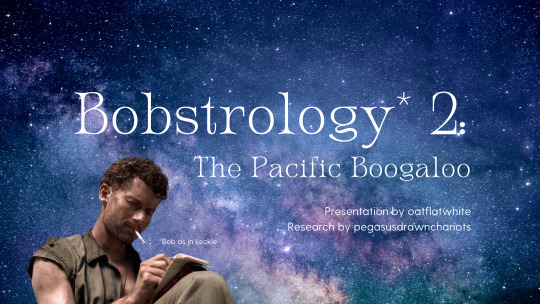
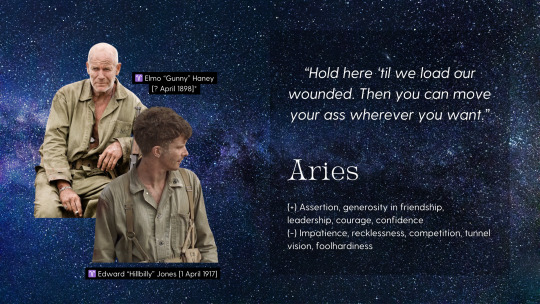

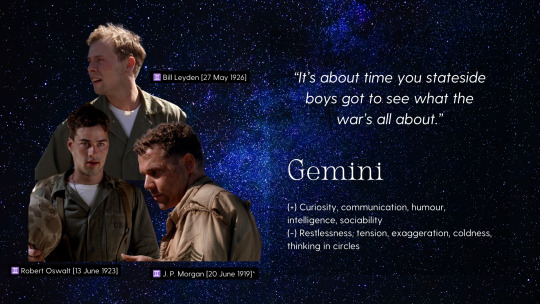
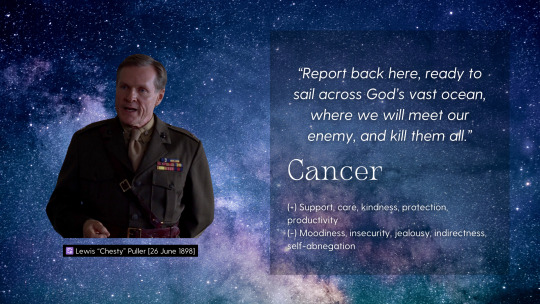
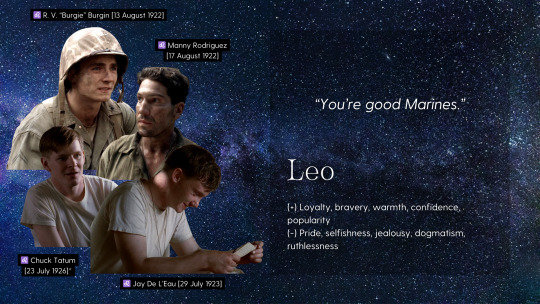
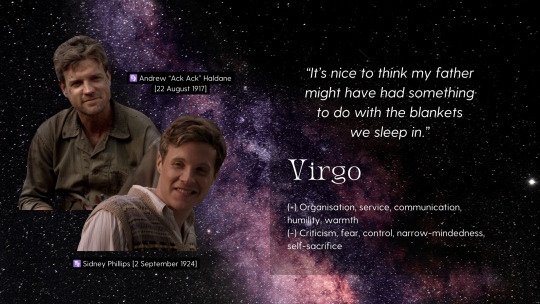

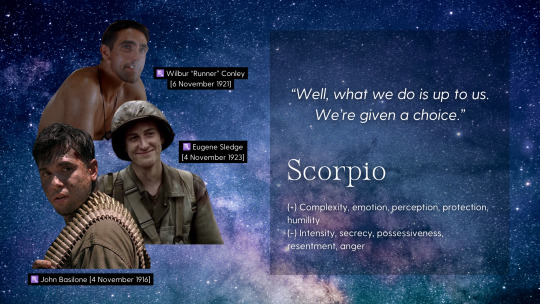
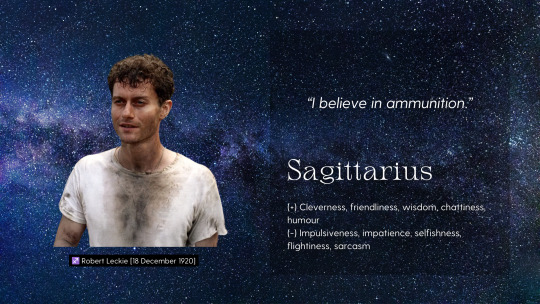
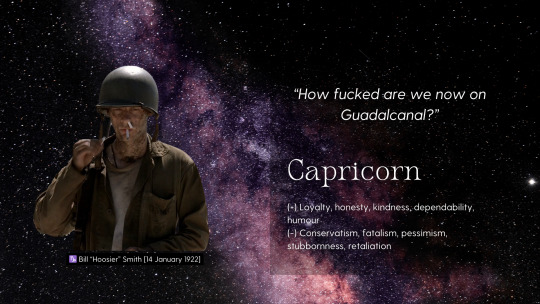
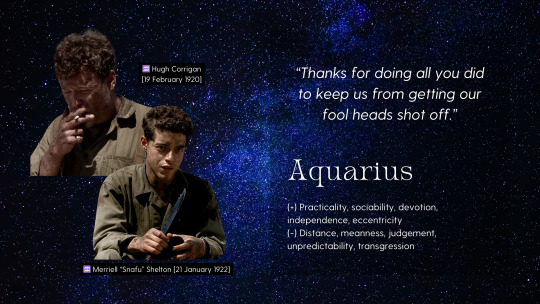


BOBSTROLOGY 2: THE PACIFIC BOOGALOO
Another completely serious presentation by @pegasusdrawnchariots and oatflatwhite
written version under the cut!
♈️ Edward “Hillbilly” Jones – 1 April 1917 ♈️ Elmo “Gunny” Haney – ?? April 1898 * ♉️ Clifford "Steve" Evanson – 25 April 1926 ♊️ Bill Leyden – 27 May 1926 ♊️ Robert Oswalt – 13 June 1923 ♊️ J. P. Morgan – 20 June 1919 * ♋️ Lewis “Chesty” Puller – 26 June 1898 ♌️ Chuck Tatum – 23 July 1926 * ♌️ Jay De L’Eau – 29 July 1923 ♌️ R. V. "Burgie" Burgin – 13 August 1922 ♌️ Manny Rodriguez – 17 August 1922 ♍️ Andrew “Ack Ack” Haldane – 22 August 1917 ♍️ Sidney Phillips – 2 September 1924 ♎️ Vera Keller – 13 October 1923 ♎️ Lew “Chuckler” Juergens – 22 October 1918 ♏️ John Basilone – 4 November 1916 ♏️ Eugene Sledge – 4 November 1923 ♏️ Wilbur “Runner” Conley – 6 November 1921 ♐️ Robert Leckie – 18 December 1920 ♑️ Bill “Hoosier” Smith ��� 14 January 1922 ♒️ Merriel “Snafu” Shelton – 21 January 1922 ♒️ Hugh Corrigan – 19 February 1920 ♓️ Lena Riggi Basilone – 7 March 1913
2 Aries 1 Taurus 3 Gemini 🥈 1 Cancer 4 Leo 🥇 2 Virgo 2 Libra 3 Scorpio 🥈 1 Sagittarius 1 Capricorn 2 Aquarius 1 Pisces
7 🔥 4 🪨 7 💨 5 💧
6 cardinal 10 fixed 7 mutable
14 masculine 9 feminine
* Gunny Haney's day of birth is not known; we went with Aries on vibes * J. P. Morgan's birthday was taken from The Pacific wiki but we couldn't verify it elsewhere (or whether he was actually a real dude?) * Chuck Tatum is a cusp and we assigned him Leo based on his city of birth if he had been born at noon; also on vibes
** Other characters in The Pacific are based on people from Leckie and Sledge's memoirs, but their names are either changed or they are only referred to by surname and quite unidentifiable, based on my (oatflatwhite's) original search (which was not exhaustive!). Ronnie Gibson and Stella Karamanlis, for example, seem to be based off of real people Leckie encountered during the war, but were not their actual names. Others, like minor officers in both K and H companies, and the doctors Leckie sees, I just couldn't track down. We could locate the birthdays of Sledge's family (brother and parents) but since we couldn't do the same for Leckie and Basilone, we left them off this list. They're two more Scorpios and another Virgo, by the way.
*** And if you've read this far, @pegasusdrawnchariots assigned Stella Leo based on vibes :-)
#the pacific#hbo war#thepacificedit#hbowaredit#bobstrology#liz makes things#robert leckie#eugene sledge#john basilone#et cetera et cetera#phew what an undertaking
89 notes
·
View notes
Text
Another mysterious infectious fatal disease has emerged outside the US.
At least 79 people have died from an unknown disease that is causing flu-like symptoms in south-western Democratic Republic of Congo, the health ministry says. The health ministry says the majority of people who have died are between the ages of 15 and 18. More than 300 people have been infected with patients exhibiting symptoms like fever, headaches, runny noses and coughs, breathing difficulties and anaemia.
If you do the math, this infection has a death rate of over 25%. It also targets young people like the deadly "Spanish Flu" pandemic of 1918-1919. Being "flu-like" means it may be difficult to distinguish from typical seasonal influenza. That also implies that it could easily be transmitted like the flu.
Response teams have been sent to Kwango Province, specifically the Panzi health zone, where the disease is most common, to manage cases and investigate the nature of the disease. Cephorien Manzanza, a civil society leader, told Reuters news agency the situation was worrying as the number of infected people continues to rise. "Panzi is a rural health zone, so there is a problem with the supply of medicines," he said. A World Health Organisation (WHO) Africa region official told the BBC they have "dispatched a team to the remote area to collect samples for lab investigations". Authorities have urged the population to remain calm and vigilant.
Kwango Province is adjacent to the region where the capital Kinshasa (pop. 17 million) is located.
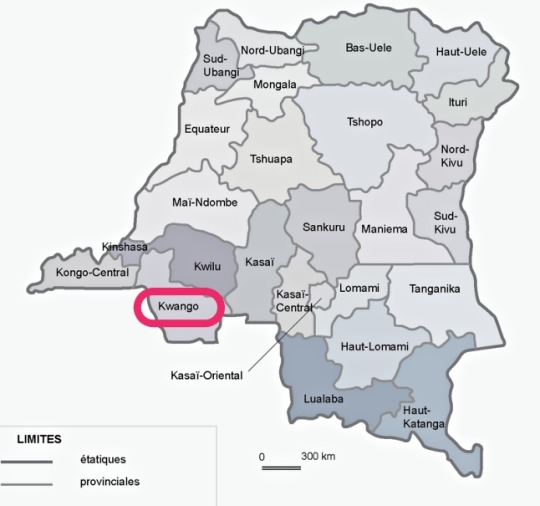
If the Kwango infection spreads to the US after Trump's inauguration, we would be in even worse shape than when COVID-19 came to the US. Instead of Dr. Anthony Fauci, we'd have anti-vaxxing quacks like RFK Jr. and other clowns running American public health.
Trump himself would try to underplay a new pandemic the way he did in 2020. In case you've forgotten, this was his reaction to the first case of COVID in the US...

Trump waited until March 13th to declare a state of emergency. COVID had already spread to most of the US during the 50 days he hoped the infection would just go away on its own.
Urge your US senator to reject any Trump public health nominee who does not accept standard scientific and medical thinking related to infectious diseases.
In the meantime, it's a good idea to catch up on related vaccinations such as seasonal flu, COVID boosters, and RSV before the December holidays.
#infectious diseases#democratic republic of congo#kwango#panzi#world health organization#flu-like symptoms#high fatality rate#donald trump#unqualified nominees#public health#rfk jr.#anti-vaxxers#quacks#covid-19#pandemic#trump botched the response to covid-19#vaccines
25 notes
·
View notes
Text
Look maybe the fandom has talked about this before but I was a literal child when the fandom was born so I'm gonna talk about it now. Childhood is temporary but fandom is forever (no it's not)
Peggy Carter's birthday on the MCU wiki is listed as April 8, 1921. Based on some speculative timelines, we can determine that the events of Captain America: The First Avenger span from approximately June 1943 to March 1945, so Peggy would have been between the ages of 22 years 2 months and 23 years 11 months.
Agent Carter season 1 takes place in April/May 1946, which we know because the season finale happens on the first anniversary of V-E Day on May 8. It's not entirely clear how many days pass over the course of the season (unless it is and I'm just not dedicated enough), but given that episodes 5-8 seem to happen over the course of about 50 hours, it seems safe to say it's about a week to ten days. This means Peggy is 25 years 1 month old at the end of the season.
However, in S01E01 "The Iron Ceiling" Daniel looks at Peggy's file to cross-reference an injury she received with the ones in the photos of the blonde at the club, who is of course Peggy in disguise. The incident report shows her age at the time of the injury as 26 years 11 months old.
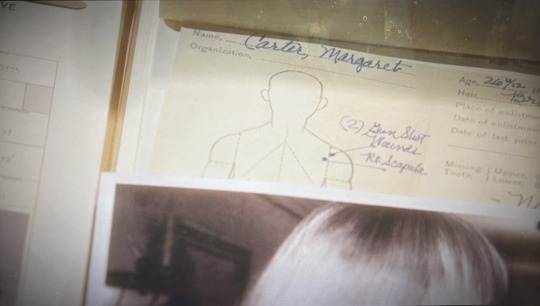
(ignore the fact that I took a picture of my laptop with my phone, the top right corner has her age)
These means one of a few things is possible. The first is that the show got her age wrong on accident, either because they didn't know her birthday or they didn't scrutinize the timeline like a fandom does, which is very likely but boring. Second is that it's possible her birthday was made canon after the show, which is also possible and boring. Another possibility is that the MCU wiki has her birthdate wrong, stating that she is younger than canon says she is, which seems unlikely to me and is also a boring explanation.
The most fun and most headcanon-y explanation is that she really was born in 1921 but she, for whatever reason, lied about her age and said she was born in 1918, making her 28 years 1 month old at the time of the first season.
1918 seems the most logical year because the show implies Daniel doesn't know about the injury, but it is established that the two have known each other for six months. If she was 27 at the time of the show the injury would be two months old and Daniel would likely know about it. Additionally, the wound appears as healed scars, meaning it has been healed for some time, likely longer than two months.
Assuming she only lied about her birth year and not the actual day, a birth year of 1918 places the injury in March 1945, which makes logical sense with the timeline of CA:TFA, placing the event in the approximately two weeks between Cap going in the ice and her birthday.
1918 also makes sense because, assuming she got involved with S.O.E. in 1940 like the show depicts, she would have been about 19 pretending to be 22. If she had lied and said she was much older, it seems likely she would have been caught in the lie. Additionally, Steve was born in 1918, Bucky and Howard in 1917, and Daniel and Jack sometime in 1918 or 1919 (the wiki is vague for both of them), so her supposed age would be consistent with the ages of the people she worked with.
I personally headcanon that she was born in 1921 and lied that she was born in 1918. I also headcanon that Michael was born in 1918 and they used the same year as if they were twins, which has far less basis in canon and is more of a little treat for me.
If anyone has insight/proof of some other alternative/theories/headcanons, let me know because I would love to hear!
#thank you for coming to my tedtalk#im just a silly girl obsessed with her silly show#agent carter#peggy carter
17 notes
·
View notes
Text

E. Prosser Rhys won the Crown in Pontypool National Eisteddfod with 'Atgof' in 1924.
Influential in his life as a poet, editor, journalist and publisher, Prosser Rhys is remembered today for winning the Crown in the National Eisteddfod of Wales in 1924. As influential as his winning poem, ‘Atgof’ was, and continues to be, Prosser even more profoundly affected Welsh-language writing in his life than is remembered today.
Edward Prosser Rees was born on the 4th of March 1901 in Trefenter, Mynydd Bach in Ceredigion, and christened on the 9th of March at Capel Bethel. His father was a blacksmith, David Rees, and his mother was Elizabeth Rees. Prosser came from a family of blacksmiths, and they later moved to Morfa Du in Trefenter (after Prosser had moved away, in March 1918). Previously, they had lived in Llainffwlbert until 1900, where they had their previous six children.
Prosser Rhys attended Cofadail Primary School in Trefenter then Ardwyn Grammar School in Aberystwyth in 1914. Other writers, academics and politicians were educated here, who were known as 'Old Ardwynians'. His early academic success was then marred by ill health - he was diagnosed with Tuberculosis at a young age, in 1915, which affected him for the rest of his life, but immediately kept him home for the next 3 years of his life.
Still, his name started appearing in Welsh writing as early as 1916, with the poem ‘Y Fam a’i Baban’ (The Mam and her Baby) in Baner ac Amserau Cymru, where he was published as E. Prosser Rees (under the pseudonym/ffugenw Eiddwenfab) from Trefenter, Llangwyryfon, Ceredigion. In 1917, he wrote eloquent letters to ‘Y Darian,’ a radical Welsh-language paper, where he first wrote briefly about joining a patriotic union, and the Eisteddfod. The latter was fitting as he next appeared in Y Darian in 1918 for his early Eisteddfod wins, then in local Eisteddfodau, listed within the winners from Ceredigion. He then appeared several times in Y Darian as a part of ‘Aelwyd y Beirdd,’ where he’s described as a young poet with great potential, at only 17, the brother of Reverend Wyre Rees.
Clearly, Prosser wrote, competed and performed his poetry quite a lot as a teenager. One of his early poems appears in ‘Cymru,’ a monthly Welsh-language journal founded by O.M. Edwards in 1891. It was in 1919 that ‘Canu’r Merched’ by E. Prosser Rhys appeared in the journal ‘Cymru’. This is the earliest (that I found) of his poetry appearing published under this name. Note that there are occasionally mentions of ‘Prosser Rees,’ his birth name, as well. As Prosser Rees, he also published a poem in 1917 in The Cambrian News and Merionethshire Standard in sympathy to Mr and Mrs Thomas Evans of Penbont, who lost their son, David Morgan, in France during the First World War.
Prosser worked as a clerk at Western Ocean Colliery in Nant-y-Moel, Ogmore Valley, before his community saw him coming back from the ‘sowth’ (south) as a journalist. He was at Nantymoel, apparently living with one of his brothers, John, who was a coal miner. He was still receiving treatment for tuberculosis and apparently then returned to this family in their new home in Morfa-Du. He then worked at the Liberal newspapers of the Welsh Gazette in Aberystwyth and Herald Cymraeg in Caernarfon in 1919 (where he worked with Morris T. Williams). He moved back to Aberystwyth in 1921 and became the editor of Baner ac Amserau Cymru in 1923, when they moved their offices from Denbigh to Aberystwyth.
In 1923, Prosser's poetry was first published in a book - Gwaed Ifanc with another poet J.T. Jones (John Tudor Jones). As the title suggests, they were proud of being the ‘new blood’ of Welsh poetry and writing, with Prosser then being 22 and J.T. Jones being 19 years old. There was certainly some backlash to that and the book was met with some controversy, also for their poetry being more sexual than older poets of the time. There was already a tradition of the new kind of Welsh writing, started by T H Parry-Williams’ win in the Eisteddfod in 1915 with ‘Y Ddinas,’ and Rhys was aware of these new ideas of challenging Welsh writing, the Eisteddfod and therefore Welsh-language society, which he was inspired by and sought to be a part of - and succeeded. This was an attempt to challenge the writing of older poets, as well as bring attention to the newer crop of younger writers, the men who’d survived the First World War and demanded attention.
He of course especially challenged the status quo of the Eisteddfod when he won the Crown in 1924 in the Pontypool National Eisteddfod with his poem ‘Atgof’ (Memory - or also sometimes translated as Reminiscence). This long ‘pryddest’ poem, follows a ‘llanc synhwyrus’/‘sensible lad’s journey into exploring his sexuality, from seeing ‘Sex’ ruin his parents’ relationship, to exploring his sexuality with women, and then with a man as well (who was likely Morris T. Williams), while struggling against the morals and virtues of Welsh society and religion. The judges of the Eisteddfod were at odds, one finding it to be immoral and the others praising it.
Of course, when Prosser won, the reactions were scandalized and ‘Atgof’ became quite controversial, for its explicit discussions of sex and of course the same-sex part of the poem. It has since been called ‘homoerotic’ by many writers, while today may be seen more as a bisexual poem, or queer one. Mihangel Morgan, writing in Queer Wales, finds this to be a negative depiction of homosexuality and downplays the significance of ‘Atgof’ as a gay poem.
A’n cael ein hunain yn cofleidio ‘dynn;
A Rhyw yn ein gorthrymu; a’i fwynhau; A phallu’n sydyn fel ar lan y llyn…
And finding ourselves in a tight embrace With Sex overwhelming us; and enjoying it;
And suddenly stopping as above the lake…
These lines describe the same-sex interaction and indeed it doesn’t take up a large amount of the poem, but Mihangel Morgan’s disappointment seems to come from the poem not being homosexual enough. And indeed it isn’t, but reads as a bisexual poem that takes us through Rhys’s whole journey of realising and battling with his sexuality at this age. It still resonates with much of the LGBTQ+ community, especially when realising how explicit it was for 1924 (or it wouldn't have been so controversial), 40 years before the decriminalization of homosexuality, and its win in the Eisteddfod was well, well ahead of its time.
On the other hand, later on in Prosser’s life, it was suggested that he was so shocked by sodomy in the writing of someone else to not publish them. There is the possibility of Prosser’s viewpoints and own sexuality changing in his life, though this is merely speculation that Prosser was ‘shocked’ by writing of homosexuality. There are many possibilities here when it comes to Prosser’s own feelings and sexuality, but it is certain that they have had a great influence on LGBTQ+ writing and the community in Wales and particularly in Welsh.
‘Atgof’ and Prosser were also mentioned in US Time Magazine in 1924, adding to evidence of the influence and legacy of this poem. Internationally, we see links in the poems to the sexology and psychiatry of the time - the psychoanalyst Ernest Jones (and possibly abusive husband of the composer Morfydd Llwyn Owen) mentioned the poem in a letter to Sigmund Freud, though it’s unclear that either actually read the poem.
Caradog Pritchard wrote in his autobiography that as a friend of Prosser’s and Morris T. Williams’ that he believed the man Prosser wrote about was Morris Williams, and this has been accepted as likely the truth since then (though there were always rumours about this). Morris T. Williams was close to Prosser, when they were roommates in Twthil near Caernarfon, while working at 'Herald Cymraeg,' and they exchanged letters after which show their close relationship - this was before Morris married Kate Roberts and they together bought Gwasg Gee. All three remained close, being friends and remaining in the same social circles as poets, as well as in Welsh publishing. More recently, it has been theorized that Kate Roberts also was queer, based on her own personal writing, as well as her short stories which are about romantic relationships between women (such as 'Christmas' and 'The Treasure'). Morris T. Williams died in 1946, a year after Prosser Rhys, after a long struggle with alcoholism.
‘Atgof’ was published as a booklet, with a translation ‘Memory’ by Hywel Davies also published as a booklet. The poem reads less explicitly than the Welsh version, though it was praised at the time. It can be read here - though a modern English translation is definitely needed. 'Atgof' can also be read here.
In 1928, Prosser married Mary Prudence Hughes in Aberystwyth, which was when both he and she took the surname ‘Rhys’. They had one daughter, Eiddwen Rhys. He founded Gwasg Aberystwyth also in 1928 and began publishing books, with Gwasg Aberystwyth growing significantly in years to come.
As editor of Baner ac Amserau Cymru, Prosser encouraged more poets to write and publish their work. Rhys founded Y Clwb Llyfrau Cymraeg/The Welsh Books Club in 1937. This was a subscription of Welsh books, where readers would receive 4 books a year for half a crown, and which published 45 volumes up until 1945. As successful as it was under Prosser, after his death, it was decided that there were not enough Welsh-language writers to continue it.

(Executive committee of 'Plaid Genedlaethol Cymru,' 1927- Lewis Valentine, Ambrose Bebb, D. J. Williams, Mai Roberts, Saunders Lewis, Kate Roberts, H. R. Jones, Prosser Rhys.) Prosser Rhys was a founding member of Plaid Cymru, founded in 1925. He was also the editor of ‘Y Ddraig Goch’ with Saunders Lewis and Iorwerth C. Peate, which Prosser also helped to form with H. R. Jones, though he was initially opposed to the idea due to lack of funds. However, Prosser became vocally opposed to Saunders Lewis’ right wing views. He wrote in Y Faner that many of Plaid Cymru’s members had come from the Labour party or Liberal party, or were radicals who came from no political party, where none were supportive of the views appearing in the Daily Mail, implying that Saunders Lewis’ views were too close to the matter, but that most Plaid Cymru supporters were personally too loyal to voice their concerns over this. The expulsion of Prosser from the party was discussed and suggested but Saunders Lewis opposed this.
Following his many successes, Prosser and his family moved to 33 North Parade, Aberystwyth, where he lived until his death.

After his health had deteriorated again from 1942, Prosser died in 1945 - at the age of 43, and less than a month before his 44th birthday. He is buried at Llanbadarn Fawr Cemetery, with his grave quoting T. Gwynn Jones: “Gwyrodd êfo î’r drugaredd fawr, Ni wyr namyn Duw ddirgelwch ei wên.” Here Mary Prudence Rhys, his wife, is also buried, who died in 1991, at the age of 87. They are also buried with William Dewi Morris Jones, who died in 1983, aged 56. Rhys’s death was certainly a loss to Welsh publishing and writing.
Gwasg Aberystwyth was bought by J. D. Lewis & Sons from Llandysul after Prosser’s death, the founder of Gwasg Gomer, who continued the Welsh Books Club and took over publishing of the club’s books until 1952. This, however, did follow a legal disagreement between Mary Prudence Rhys and Morris T. Williams, who was supposed to get the first offer and chance at refusal for Gwasg Aberystwyth, according to legal documents that Prosser and Morrisagreed upon, which Morris Williams did not feel like he had gotten.
Cerddi Prosser Rhys was published in 1950 by Gwasg Gee, Morris’s first collection entirely of his own poems - published 5 years after his death. Edited by J.M. Edwards, a fellow poet who competed in Eisteddfodau and was from a similar area to Rhys, Edwards also writes the introduction of the poetry collection. He notes that he decided that 4 years after Prosser’s death was enough time to finally publish a whole collection of Prosser’s best poems (the introduction was written in July, 1949, with the book published in February, 1950.) He writes that his previous poetry collection, in ‘Gwaed Ifanc’, was ‘a volume that attracted a lot of attention and also brought a new, daring note to the world of Welsh poetry of the period, something that was urgently needed.’ His memories of Prosser while growing up show he was a well-known poet even in his youth, who Edwards and others in his own school had heard of before meeting, who was known for competing and finding success in many local Eisteddfodau around Wales.
Of his poetry found in Cerddi Prosser Rhys, Edwards notes that ‘Y Gof’ (The Memory) is a tribute to his parents and his early life in rural Wales. His two sonnets he most praises are ‘Y Pechadur’ (The Sinner) and ‘Duw Mudan’ (Mute God). Of ‘Atgof,’ Edwards significantly notes that it was "a bold poem that created a lot of excitement and was praised by some but damned by others. The saddest feature of the whole event was that it reflects an attitude of thought in Wales which is too ready to judge the values of the world of the arts by the wrong standards." The introduction finishes by repeating what many others have said about the premature loss of Prosser to the world of Welsh writing and publishing. Edwards also hoped that there would also be a collection of Prosser’s prose, which unfortunately has not yet come to be.
‘Mab ei Fam’ (His Mother's Son) is to "M.T.W," likely Morris T. Williams - similarly to Strancio, which was translated by Mihangel Morgan as ‘Fooling About,’ which is to: ‘I gyfaill annwyl a fu’n cyd-letya â mi’ (To a dear friend who lodged with me)
Do, bûm yn flin. Ond weithian gwybydd di Fod Fflam yn llosgi ynof, ac aml dro Yn llamu ar draws fy nghorff materol i, A’m hysu hyd fy nghyrru i maes o’m co’,
A strancio a wnaf eto rhag fy ffawd Nes torro’r Fflam ei ffordd o’i charchar cnawd.
Yes, I was angry. But sometimes you must know That a Flame burned within me, and often Sprang from my material body Plaguing me until it drove me mad And I would taunt my fate Until the Flame broke free of its prison of flesh.
-Mostly translated by Mihangel Morgan.
As with ‘Atgof,’ Mihanel Morgan downplays Strancio by stating it to be cryptic and guarded - while I'd argue that the confession of his feelings towards a man in the 1920s is explicit for its time, especially following on from the Victorian poetry that was popular before the ‘New blood’. While Mihangel Morgan says it is ‘assumed’ to be about Morris T. Williams, the dedication at the start of the poem is clear enough, at least historically, to Morris T. Williams, especially when a previous poem also is dedicated to him.
It wasn’t until 1980 that Prosser Rhys was celebrated with a book about his life, by Rhisiart Hincks. T. Robin Chapman wrote in Y Traethodydd in 2006 that Hincks probably knew of the nature of Rhys’s relationship with Morris T. Williams yet it was omitted, from the only whole biography of Prosser Rhys. This is a sign of the times in which it was written and published but shows the need now to write biographies of Rhys that include what was previously excluded, his queer identity. Hincks mentions how Williams quickly became Prosser's best friend ('ei gyfaill pennaf') when they met in Caernarfon, that they moved together to 15 Eleanor Street and that it was Prosser who introduced Williams to literature. ‘Cyfeillgarwch clos’. He also mentions that such closeness led to spats, once when they fought all night, which does show the intensity of their relationship. Perhaps, this subtext Hincks hoped to be understood by the audience of the time. Of ‘Atgof,’ Hincks notes that Prosser had previously expressed that there was a lack of sex in Welsh in recent poetry, which he blamed on the chapel. This biography remains the most detailed on Prosser’s life.
A monument on Mynydd Bach, overlooking Llyn Eiddwen near to Trefenter, where Prosser was born and lived in his childhood, was unveiled in 1992, during the National Eisteddfod in Aberystwyth. Including Rhys, the monument, ‘Cofeb i Feirdd y Mynydd Bach’ celebrates 4 poets from the local area. J.M. Edwards from Llanrhystud also won the Crown in the National Eisteddfod, in 1937, 1941 and in 1944, and wrote the introduction to Cerddi Prosser Rhys. All 4 of the poets named on the plaque of the monument were successful in the Eisteddfod. B. T. Hopkins (Benjamin Thomas Hopkins) was a successful poet from Ceredigion, who lived and farmed on Mynydd Bach. T Hughes Jones (Thomas Hughes Jones) was a Welsh poet and writer from Ceredigion who won a medal in the National Eisteddfod of 1940 for a short story, ‘Sgweier Hafila,’ which was partly judged by Kate Roberts.
Interest in Prosser, his life and career, has been renewed by research into Welsh LGBTQ+ history and writing. Notably, in 1998, a historical docudrama called ‘Atgof’ aired on S4C, directed by Ceri Sherlock, which depicted Prosser writing the poem and his relationship with Morris T. Williams, which was represented as a sexual and romantic one. There was controversy around the film, similarly to 'Atgof' the poem, with some questioning how they depicted the relationship (with some speculated, fictional details) and some also questioning whether it should be depicted or speculated about at all. Despite the discourse, Prosser Rhys had already become an inspiration to the Welsh LGBTQ+ community.
In 2019, the show ‘Corn Gwlad’ was performed at the National Eisteddfod in Llanrwst, created by Seiriol Davies, which celebrated Prosser’s win at the Eisteddfod and depicted his feelings towards Morris T. Williams. It was then a work-in-progress show, with comedy and music, and part of the ‘Mas ar y Maes’ programme of events at the National Eisteddfod, which are especially for the LGBTQ+ community, or which may be relevant to the LGBTQ+ community. Prosser was also featured in ‘Mas ar y Maes’ events with ‘Cariad yw Cariad,’ and is of course heavily featured in the 2024 National Eisteddfod in Pontypridd, on the centenary of Prosser Rhys winning the Crown with 'Atgof.' 'Atgof' was also the theme of the poems submitted to the 'Coron' - which was won by Gwynfor Dafydd.
The lasting legacy of Prosser Rhys is to be a significant voice of this community from 20th century Wales, and an icon especially for Welsh language LGBTQ+ people, queer men and bisexual people. This is what has significantly brought Prosser Rhys back into the public eye in the 1990s, with the film Atgof, and in the 2010s with LGBTQ+ History Month, and in the 2020s around the 100th anniversary of his Eisteddfod Crown winning with ‘Atgof’. Prosser also had a significant impact in Welsh publishing, Welsh society, in his article writings, in politics. Prosser Rhys was a fascinating, complicated person, a passionate advocate for Welsh poetry, writing and publishing and is a hero of the communities to which he belonged, including the local community in Ceredigion and West Wales.
#edward prosser rhys#prosser rhys#e. prosser rhys#eisteddfod#national eisteddfod#lgbtqia#queer history#welsh history#history#wales#bisexual history#gay history#queer welsh history#this is a very long blog - this can't really be called a blog#Welsh version incoming soonish#posting this in the middle of the night bc I go to the Eisteddfod tomorrow
32 notes
·
View notes
Text
Okay @scarlet-bitch (hope you don’t mind the tag) this is the very basic like timeline of that thing I mentioned. It’s a super crossover xD
—//—//—//—
1917
James “Bucky” Barnes is born March 10
Howard Stark is born August 15
1918
Steve Rogers is born July 4
1921
Margaret “Peggy” Carter is born April 21
1930
Eric Lehnsherr is born May 25
1932
Charles Xavier is born July 13
1939
Howard Stark starts up Stark Industries
1950
Nick Fury is born July 4
1954
John Winchester is born April 22
Mary Winchester is born December 4
1956
David Rossi is born May 9
1958
Henry Winchester stumbles upon a mutant/human co-op trying to force mutations in humans. He is saved by an undercover CIA agent and forced into Witness Protection without his wife and child. The CIA agent has betrayed the CIA and is instead working with the co-op.
The CIA agent, calling herself Abbadon, starts to subtly threaten Millie.
1960
Harold Finch (Thomas) is born April 9
1962
Abbadon injects John with a prototype serum that is supposed to force a mutation out of him. It seems to fail.
Nathan Ingram is born June 6
Olivia Manx is born July 5
1964
Phil Coulson is born July 8
1965
Abbadon scares Millie, who believes that she has hidden John’s existence from Abbadon as the ex-CIA agent never threatens him, away. Millie leaves John with her sister Maisy. She takes on the name Maria.
Millie meets and falls in love with Howard Stark.
Nathan Ford is born August 16
Carl Elias is born August 18
1966
Robert Hersh is born May 7
Mark Snow is born May 22
1967
Anthony Marconi is born November 23
1968
Lionel Fusco is born March 17
James “Rhodey” Rhodes is born October 6
1969
Bruce Banner is born December 18
1970
Tony Stark is born May 29
Emily Prentiss is born October 12
1971
Clint Barton is born June 18
Aaron Hotchner is born November 2
1972
Joycelyn Carter is born March 7
Haley Hotchner is born July 16
1973
Derek Morgan is born June 6
1974
Pepper Potts is born February 12
1975
John Reese (Harris) is born May 4
1977
Elle Greenaway is born June 24
Penelope Garcia is born July 7
1978
Sam Wilson is born September 23
1979
Dean Winchester is born January 24
1981
Samantha Groves is born September 4
Sean Hotchner is born August 7
Spencer Reid is born October 28
1982
Maria Hill is born April 4
1983
Grant Ward is born January 7
Sam Winchester is born May 2
Nathan Ingram leaves MIT with an unfinished degree to start IFT May 29
Michael Cole is born July 10
Sameen Shaw is born October 25
Mary Winchester dies November 2
1984
Jessica Moore is born January 24
Will Ingram Finch is born August 31
Natasha Romanov is born November 20
1985
Devon Grice is born November 30
1986
Alec Hardison is born April 13
Dum E is created June 18
1987
Tony graduates from MIT June 5
Leo Fitz is born August 19
Jemma Simmons is born September 11
1988
Skye (Daisy Johnson) is born July 2
1989
This is the last year that Millie Winchester was seen alive. This is because she abandons the name and steps fully into her Maria Stark alias.
Pietro & Wanda Maximoff are born January 1
1990
Adam Milligan is born September 29
1991
Maria and Howard Stark die December 16
1992
Theresa Whitaker is born March 7
John Winchester drops his sons off with his half brother Tony Stark April 20
July 20 Tony manages to gain custody of his nephews.
1993
John Winchester suffers a mental break and kills Kate Milligan and kidnaps his son on October 3
October 11 Adam is dropped of with Tony which causes a scandal
1995
Caleb Phipps is born July 26
1997
Taylor Carter is born June 18
1999
Masha Ingram-Finch is born February 24
2000
Lee Fusco is born January 9
2001
Peter Parker is born August 10
2003
Genrika Zhirova is born December 13
2004
Lionel and his wife divorce
2005
Jack Hotchner is born October 7
“The Machine” goes online February and the next day sold.
2007
On February 5 Tobias Hankel kidnaps Spencer Reid.
2008
Henry LaMontagne is born November 12
2009
Tony is kidnapped by 10 Rings February 13
2010
The Ferry bombing happens killing Nathan Ingram September 26
Sometime during October or November Rick Dillinger is hired by Finch
Dillinger dies December 5ish
2012
May 4; Battle of New York happens.
#inkstained rambles#marvel cinematic universe#person of interest#criminal minds#super crossover#the supernatural are mutants
12 notes
·
View notes
Text

Prince Arthur, Duke of Connaught decorating Lieutenant General Henry George Chauvel, commanding the Anzac Mounted Division. Jerusalem, 19 March 1918.
#World War One#The Great War#1918#1917#1916#1914#first world war#history#historical#historical photos#world history#canadian history#military history#british army#Indian History#war#military#somme#Battle of the Somme#france#belgium#the western front#vimy ridge#Battle of Vimy Ridge
35 notes
·
View notes
Text

Dr. Yosef Ben-Jochannan (December 31, 1918 - March 19, 2015) was a historian whose work is focused mainly on the Black presence in ancient Egypt. He contends in his writings that the pharaohs came out of the heart of Africa that the original Jews were from Ethiopia and were Black Africans, and that the white Jews adopted the faith and customs.
He was born an only child to an Ethiopian father and an Afro-Puerto Rican Jewish mother in a Falasha community in Ethiopia. He attended schools in Brazil, Spain, Puerto Rico, and Cuba and earned degrees in Engineering and Anthropology. He continued his education at the University of Havana, where he earned an MS in Architectural Engineering. He earned a Ph.D. in Cultural Anthropology from the same school, and he attended the University of Barcelona, where he earned a Ph.D. in Moorish history.
He immigrated to the US in the early 1940s. He was appointed chairman of the African Studies Committee at UNESCO headquarters. He began teaching Egyptology at Malcolm King College and he taught at City College in New York. He was an adjunct professor at Cornell University. He has taught at Columbia University, Al-Azan University, and Rutgers. He led an archaeological dig in the Nubia region of Egypt and led an annual trip of Black people to Egypt.
He is a prolific author, penning 49 books, such as Black Man of the Nile and African Origins of Western Religions. The subject of most of his books is ancient Nile Valley civilizations. He wrote and co-wrote elementary and secondary school texts. He is the chair of the publishing house Alkebu-Lan Foundation and its subsidiary, Alkebu-Lan Books and Education Materials Associates. He donated his library of more than 35,000 volumes to the Nation of Islam in 2002. #africanhistory365 #africanexcellence
5 notes
·
View notes
Text
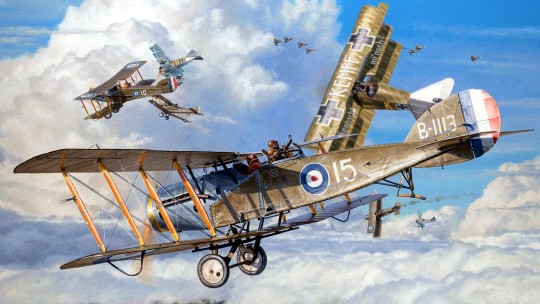
1918 04 Remember me - Russell Smith
Remember Me? depicts a hypothetical but plausible encounter between and Bristol F2.b of 48th Squadron, RAF and a Fokker Dr.1 triplane piloted by Leutnant d. R. Friedrich "Fritz" Kempf of Jasta 2 (Boelcke). The scene depicts Kempf zooming up and past the Bristol, catching the crew by surprise. The client was fairly specific about the attitudes and positions of the aircraft, but he left the overall composition and the choice of Bristol markings up to me.The Bristol Fighter was a maneuverable, heavily armed two-seater biplane, and one of the most successful fighters of the war. It got off to a poor start during "Bloody April" when it was introduced to the Western Front by the inexperienced pilots. Believing that the aircraft was structurally weak, pilots avoided violent maneuvers during combat. It was soon realized, however, that the Bristol fighter was actually a very sturdy aircraft that could be maneuvered as if it were a single seat fighter with rear protection. Bristol crews met with great success by using their aircraft in that capacity. By the end of the war over 240 pilots and gunners achieved ace status in the type. My choice of markings for this particular Bristol was personal. Growing up in SC I often attended the Shawfest airshow at Shaw Air Force Base located in Sumter. In my 20’s, as a budding aviation artist, I donated a painting to the 20th Fighter Wing which was based at Shaw AFB at the time. For those reasons I have had long felt a familiar connection to Shaw AFB. A few years back, though that connection became very personal. While doing some research on Ancestry I found that I had a great great grandfather who was a Shaw and who was born in Sumter, SC. I knew immediately there had to be a connection to Shaw AFB. After further research I came to find that Shaw AFB was named after 1st Lt. Ervin David “Molly” Shaw, the first Sumterite killed in the WWI & the only Sumter Aviator to die in combat. Shaw served with the 48th Squadron, RAF, British Expeditionary Force. In combat, he is credited with shooting down two enemy aircraft. On July 9, 1918, well behind enemy lines on a scouting mission, he and his British observer were greatly outnumbered by enemy scout planes and they perished in battle. They were flying Bristol F2b B-1113 at the time. As it turns out, 1st Lt. Ervin David Shaw, after whom Shaw AFB is named, was my great-grandmother’s cousin!Frederich "Fritz" Kempf was born in May 1894 in Freiburg in the town of Breisgau in the southwest of Baden-Württemberg. At age 19, he joined infantry in October 1913 and by August of the following year was promoted to Unteroffizier . After being wounded in battle and a lengthy hospital stay he applied for a transfer to the Luftstreitkraefte. Once accepted he arrived at FEA 3 in Gotha on May 6, 1915. He was then sent back to Freiburg to complete training and then on to FEA 9 at Darmstadt at the end of November 1915. In March 1917, after serving with various aviation units, he received the Iron Cross 1st Class and joined Jasta 2 "Boelcke". He scored his first victory on 29 April - a BE2c near Le Pave. His second was a Sopwith Pup on 5 June at Masnieres, then the 3rd was a Camel on 20 Oct. at Gravenstafel.He was sent to Jasta-Schule I as an instructor , returning to Jasta Boelcke in January 1918. On 8 May he scored his fourth victory, a Camel west of Steenwerke. He returned to Jasta-Schule I in August 1918 where he served until the end of the war. Although he only had 4 victories to his credit at war’s end, Kempf was none the less a respected and valued member of Jasta Boelcke. He died in August 1966.Of the aircraft that Fritz Kempf flew during his wartime career, perhaps the most recognizable were a pair of Fokker Dr.1 triplanes which carried similar
47 notes
·
View notes
Text

Captain Cyril Maxwell Curtis, MC & Bar, 24th Battlion Royal Fusiliers.
Won the MC and Bar within the space of 9 months, at the tender age of 19.
MC gazetted 25th March 1918 (Action was November 1917) for engaging the enemy in a bomb fight and drove the enemy, who were in superior numbers, from their position.
Bar gazetted 2nd December 1918 (Action August 1918) for finding an enemy officer collecting a considerable number of his own men to oppose an advance. He, with two men, charged the enemy and compelled the surrender of the whole party.
Cyril, a Bath native, survived the war & lived in Newbridge, Somerset.
9 notes
·
View notes
Text
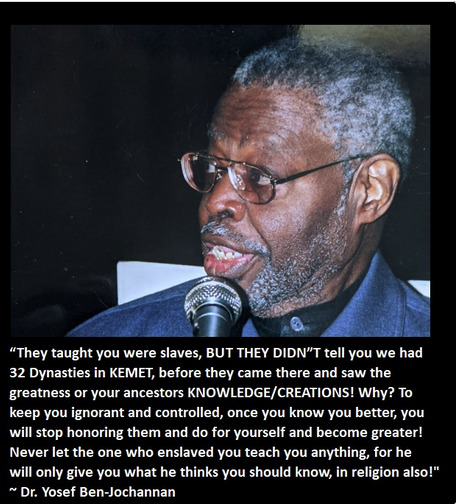
BORN ON THIS DAY IN 1918 ❤️🖤💚 Yosef Ben-Jochannan was an Afrocentric historian whose work focused mainly on the black presence in Ancient Egypt. He contends in his writings that the pharaohs came out of the heart of Africa and that the original Jews were from Ethiopia and were black Africans, and the white Jews adopted the faith and customs later. He has been accused of distorting history, and since his work contradicts the prevailing view of Egyptian and African history, it is controversial. Ben-Jochannan was born an only child to an Ethiopian father and an Afro-Puerto Rican Jewish mother in a Falasha community in Ethiopia. He attended schools in Brazil, Spain, Puerto Rico, and Cuba and earned degrees in engineering and anthropology. He continued his education at the University of Havana, Cuba, where he earned a Master’s degree in architectural engineering. He earned a doctoral degree in cultural anthropology from the same school. Finally, he attended the University of Barcelona, where he earned another doctoral degree in Moorish history. Ben-Jochannan immigrated to the United States in the early 1940s. He was appointed chairman of the African Studies Committee at UNESCO headquarters in 1945. He served in that position until 1970. Ben-Jochannan began teaching Egyptology at Malcolm King College in 1950, and then he taught at City College in New York. He was an adjunct professor at Cornell University from 1976 to 1987. He has also taught at Columbia University, Al-Azan University, and Rutgers. He led an archaeological dig in the Nubia region of Egypt in the 1990s and also led an annual trip of black people to Egypt. Ben-Jochannan is a prolific author, penning 49 books, such as Black Man of the Nile and African Origins of Western Religions. The subject of most of his books is ancient Nile Valley civilizations. He also wrote and co-wrote elementary and secondary school texts in the 1960s. He is the chair of the publishing house Alkebu-Lan Foundation and its subsidiary, Alkebu-Lan Books and Education Materials Associates. Dr. Yosef Ben-Jochannan died in Harlem, New York, on March 19, 2015, at the age of 96.
11 notes
·
View notes
Text


Artwork: Woman with a Monkey, 1909, which may be a self-portrait
Listen to : https://app.smartify.org/en-GB/tours/brilliant-exiles-modern-art-and-modern-women?tourLanguage=en-GB
Ethel Mars (September 19, 1876 – March 23, 1959) was an American woodblock print artist, known for her white-line woodcut prints, also known as Provincetown Prints, and a children's book illustrator. She had a lifelong relationship with fellow artist Maud Hunt Squire, with whom she lived in Paris and Provincetown, Massachusetts.
“Woman with a Monkey” was featured in the April 1909 issue of Harper’s Weekly. This painting, possibly a self-portrait of Mars, now hangs at the Springfield Art Association source

Ethel Mars (center) with her mother and aunt c.1898, Department of Image Collections, National Gallery of Art Library, Washington, DC.

Maud Hunt Squire and Ethel Mars (right), Springfield, Illinois, c.1898, Department of Image Collections, National Gallery of Art Library, Washington, DC.

Maud Hunt Squire (January 30, 1873 – October 25, 1954) was an American painter and printmaker. She had a lifelong relationship with artist Ethel Mars, with whom she traveled and lived in the United States and France. Via W

Ethel Mars, Provincetown, c.1918, Department of Image Collections, National Gallery of Art Library, Washington, DC.
#Ethel Mars#painter#american#american in Paris#art by women#art#palianshow#women's art#art herstory#Maud Hunt Squire#lesbian#queer
5 notes
·
View notes
Text














BOBSTROLOGY
A completely serious presentation by @pegasusdrawnchariots and oatflatwhite
written version under the cut!
♈️Patrick O’Keefe [April 3 1926] ♈️Robert Sink [April 3 1905] ♈️John Julian [5 April 1924] ♈️Renée Lemaire [10 April 1914] ♈️James Miller [11 April 1924] ♈️Walter “Smokey” Gordon [April 15 1920] ♉️~Ronald Speirs [April 20 1920] ♉️Alton More [April 22 1920] ♉️Henry Jones [27 April 1924] ♉️Edward “Babe” Heffron [May 16 1923] ♉️John Martin [May 12 1922] ♉️Joseph Liebgott [May 17 1915] ♉️Norman Dike [May 19 1918] ♉️William Guarnere [April 28 1923] ♊️David Webster [June 2 1922] ♊️George Luz [June 17 1921] ♊️Roy Cobb [June 18 1914] ♋️Frederick “Moose” Heyliger [June 23 1916] ♋️Albert Blithe [June 25 1923] ♋️Donald Hoobler [28 June 1922] ♋️Thomas Meehan [8 July 1921] ♋️John Janovec [9 July 1925] ♋️Robert “Popeye” Wynn [July 10 1921] ♋️James "Moe" Alley [July 20 1922] ♌️~Burton “Pat” Christenson [July 23 1922] ♌️Eugene Jackson [29 July 1922] ♌️Donald Malarkey [July 31 1921] ♌️Edward Tipper [3 August 1921] ♍️Floyd Talbert [August 26 1923] ♍️Alex Penkala [August 30 1922] ♍️William Dukeman [3 September 1921] ♎️Eugene Roe [October 17 1922] ♎️Harry Welsh [September 27 1918] ♎️Lewis Nixon [September 30 1918] ♎️Ralph Spina [October 5 1919] ♎️Thomas Peacock [October 9 1923] ♏️Denver “Bull” Randleman [November 20 1920] ♑️Lynn “Buck” Compton [December 31 1921] ♑️Antonio Garcia [January 17 1925] ♒️Richard "Dick" Winters [January 21 1918] ♒️Herbert Sobel [January 26 1912] ♒️Carwood Lipton [January 30 1920] ♒️Warren “Skip” Muck [January 31 1922] ♓️Lester Hashey [23 February 1925] ♓️Charles “Chuck” Grant [1 March 1922] ♓️Robert Strayer [March 2 1912] ♓️Wayne “Skinny” Sisk [March 4 1922] ♓️Frank Perconte [March 10 1917] ♓️Darrell “Shifty” Powers [March 13 1923] ♓️Joseph Toye [March 14 1919]
6 Aries 🥉 8 Taurus 🥇 3 Gemini 7 Cancer 🥈 4 Leo 3 Virgo 5 Libra 1 Scorpio 0 Sagittarius 🥄 2 Capricorn 4 Aquarius 7 Pisces 🥈
10 🔥 13 🪨 12 💨 15 💧
20 cardinal 17 fixed 13 mutable
22 masculine 28 feminine
#band of brothers#hbo war#bobedit#hbowaredit#bobstrology#astrology#liz makes things#disclaimer: our interpretation is ironclad. we alone decide the law. argue w the wall.#< we say as an aries and scorpio with renee and bull in our corners <3
217 notes
·
View notes